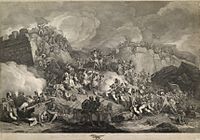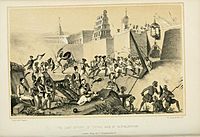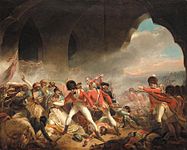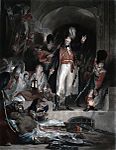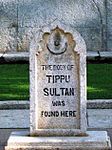Fourth Anglo-Mysore War facts for kids
Quick facts for kids Fourth Anglo-Mysore War |
|||||||
|---|---|---|---|---|---|---|---|
| Part of the Anglo-Mysore Wars | |||||||
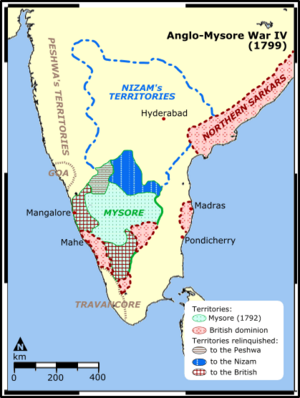 A map of the war thereafter |
|||||||
|
|||||||
| Belligerents | |||||||
|
|
|||||||
| Commanders and leaders | |||||||
|
|
||||||
| Strength | |||||||
| c. 37,000 |
East India Company: 4 infantry battalions 10,000 cavalry |
||||||
The Fourth Anglo-Mysore War was a big fight in South India between 1798 and 1799. It involved the Kingdom of Mysore against the British East India Company and the Hyderabad Deccan.
This was the last of four major wars between Mysore and the British. The British managed to capture Mysore's capital city. The ruler of Mysore, Tipu Sultan, was killed during the battle. After the war, Britain took control of Mysore. They put the old Wadiyar dynasty back on the throne. However, a British official advised the new ruler on all important matters. Tipu Sultan's young son, Fateh Ali, was sent away from the kingdom. Mysore then became a princely state, which meant it was ruled by a local prince but was under the control of British India. This new state covered parts of today's Kerala and Karnataka. The British also took some areas like Coimbatore, Dakshina Kannada, and Uttara Kannada.
Contents
Why the War Started
Napoleon's Plans and Tipu Sultan's Alliance
In 1798, a famous French general named Napoleon Bonaparte landed his army in Egypt. His goal was to capture British lands in India. The Kingdom of Mysore was very important for his plan.
Tipu Sultan, the ruler of Mysore, wanted France as an ally. He sent a letter to Napoleon asking for help. Napoleon replied, promising to free Tipu from the "iron yoke of England." Also, a French governor in Mauritius asked for volunteers to help Tipu.
However, a British admiral named Horatio Nelson stopped Napoleon's plans. Nelson defeated the French navy at the Battle of the Nile. This meant Napoleon could not send help to Tipu. Even so, the British leader, Lord Wellesley, had already started to act. He wanted to stop any alliance between Tipu Sultan and France.
The British Invasion and Victory
March to Srirangapatnam
In 1799, three armies marched into Mysore. One army came from Bombay. The other two were British armies. One of these British armies had a group led by Colonel Arthur Wellesley. He later became the famous 1st Duke of Wellington.
These armies surrounded Mysore's capital, Srirangapatnam. They had some fights with Tipu's forces along the way. On March 8, a British force successfully stopped an attack by Tipu at the Battle of Seedaseer.
Mysorean Rockets in Battle
Tipu Sultan was known for using special weapons. He used large attacks with iron-cased rocket brigades. These were rockets with iron casings. The British were very impressed by these Mysorean rockets during the Third and Fourth Mysore Wars. Their power even inspired a British inventor, William Congreve, to create his own rockets for the Napoleonic Wars.
Rockets were used many times during this war. Colonel Arthur Wellesley faced them himself. At the Battle of Sultanpet Tope, Wellesley's first attack failed. Tipu's commander, Purnaiah, fought back strongly.
A historian named Forrest wrote about it:
- Near Sultanpet village, there was a large grove of trees.
- This grove was used by Tipu's rocket soldiers.
- The British needed to clear it to get closer to Srirangapatnam.
- Colonel Wellesley was chosen for this job.
- But on April 5, 1799, he was attacked with rockets and gunfire in the dark.
- He got lost and had to stop his attack.
The next day, Wellesley attacked again with more soldiers. This time, he took the area without losing anyone.
The Final Attack on Seringapatam
On April 22, 1799, twelve days before the main battle, Tipu's rocket soldiers moved behind the British camp. They fired "a great number of rockets at the same instant." This was a signal for 6,000 Indian soldiers and some Frenchmen to attack.
These rockets could fly about 1,000 yards (about 914 meters). Some exploded in the air like bombs. Others, called ground rockets, would hit the ground and then bounce along like a snake. A young British officer named Bayly said: "We were so bothered by the rocket boys that we couldn't move without danger from their destructive missiles."
He added:
- The rockets and gunfire from 20,000 enemy soldiers were constant.
- It was like a thick hail storm.
- Every flash of blue light was followed by a shower of rockets.
- Some rockets hit the front of the column and went all the way to the back.
- They caused death, wounds, and terrible cuts from the long bamboo sticks attached to them.
During the final British attack on Seringapatam on May 2, 1799, a British shot hit a rocket storage area inside Tipu Sultan's fort. It exploded, sending a huge cloud of black smoke and bright white flashes into the sky.
On the afternoon of May 4, the final attack on the fort began. General Baird led the attack. They faced "furious musket and rocket fire." But it was not enough. In about an hour, the fort was captured. Tipu Sultan was killed shortly after. The war was over.
When the British were about to win, Tipu's French allies told him to escape. But Tipu refused. He famously said, "Better to live one day as a tiger than a thousand years as a sheep." After Tipu Sultan's death, British General George Harris said, "now India is ours."
What Happened Next
Mysore's New Rulers
The winners of the war did not divide Mysore among themselves. Instead, they sent Tipu's family away from the kingdom. They gave control of Mysore back to the old Wadiyar family.
Many people in the East India Company believed that Umdat ul-Umara, the ruler of Carnatic, had secretly helped Tipu Sultan. So, they removed him from power right after the war.
The land of the Nawab of Savanur was split between the English and Maratha forces.
Tipu Sultan's Memorial
The exact spot where Tipu's body was found under the eastern gate of the fort has been marked. The Archaeological Survey of India has fenced it off and put up a plaque. The gate itself was later taken down in the 1800s to build a wider road.
Gallery
- Fall of Tipu Sultan (1799)
-
The Last Effort and Fall of Tippoo Sultaun by Henry Singleton, c. 1800
-
General Sir David Baird, Discovering the Body of the Sultaun Tippoo Saib, After Storming Seringapatam by David Wilkie, 1843


